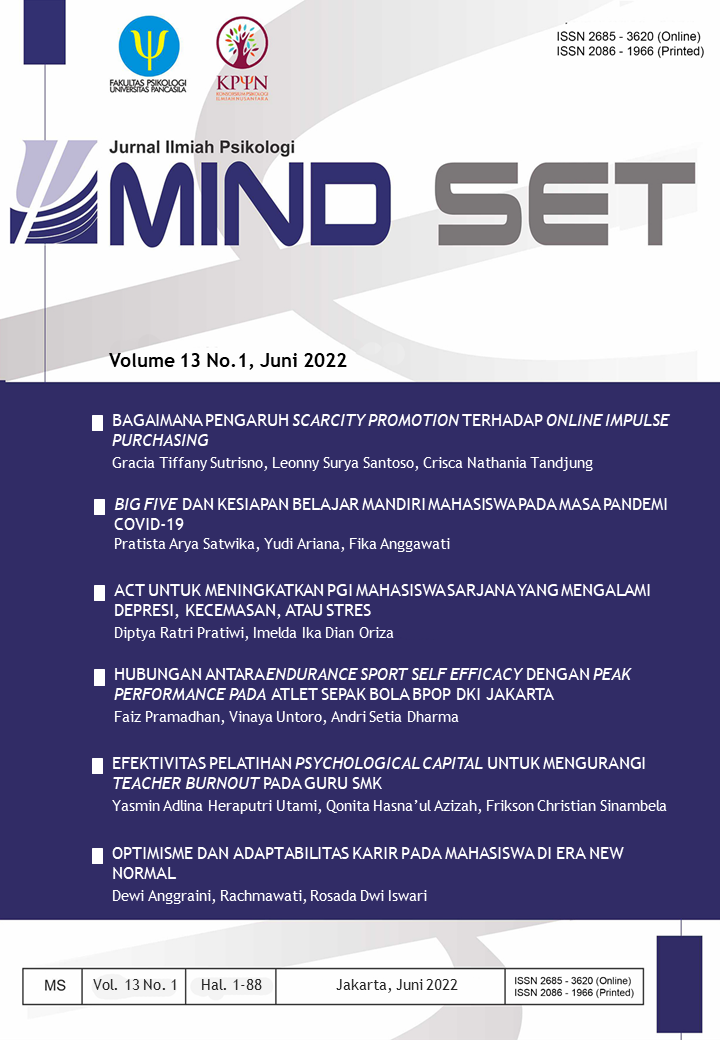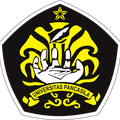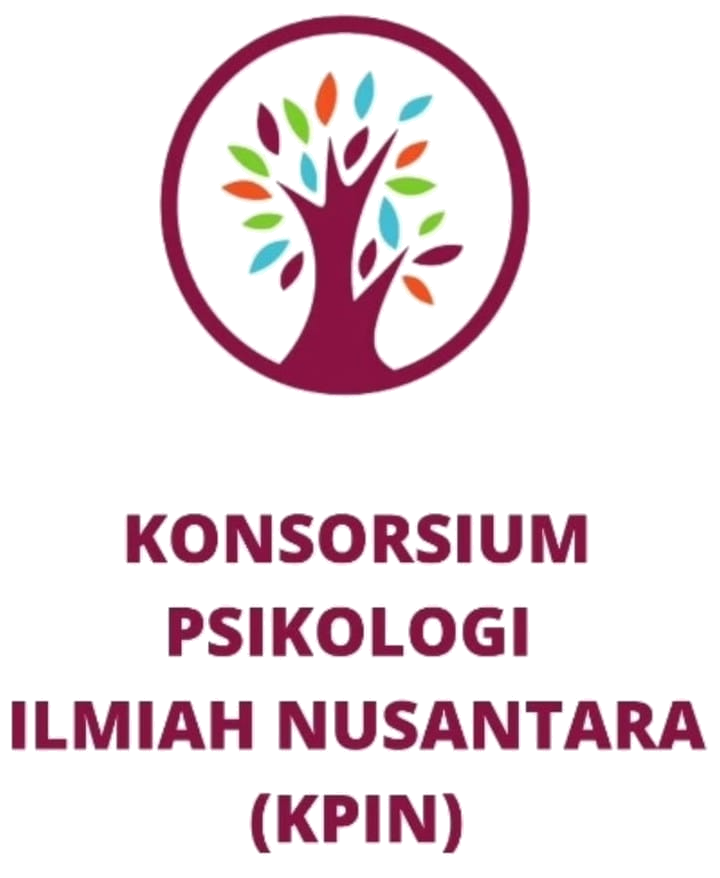Hubungan antara Endurance Sport Self Efficacy dengan Peak Performance pada Atlet Sepak Bola PPOP DKI Jakarta
DOI:
https://doi.org/10.35814/mindset.v13i01.3232Keywords:
athlete, endurance sport self efficacy, peak performance, soccerAbstract
Football is one of the most popular endurance sports in Indonesia. The high interest of the Indonesian people to become soccer athletes presents the opportunity to become athletes by joining soccer clubs to training centers to become professional players, one of which is at PPOP DKI. This study aims to examine the relationship between endurance sport self-efficacy and peak performance in soccer athletes of PPOP DKI Jakarta. The participants in this study are 43 PPOP athletes in DKI Jakarta using the total population sampling technique. The measuring instruments used in this study are the Peak Performance Instrument from Maheswari (2018) and the Endurance Sport Self-Efficacy Scale (ESSES) from Anstiss et al. (2018). The results of data analysis using pearson product moment showed that there was a significant relationship between peak performance and endurance sport self-efficacy in soccer athletes of PPOP DKI Jakarta.
References
Aldhi, R. (2018, Desember 30). Performa mantap, ini 5 pesepak bola terbaik Indonesia tahun 2018. IDNtimes. Retrieved from https://www.idntimes.com/sport/soccer/raffi-aldhi/performa-mantap-ini-5-pesepak-bola-terbaik-indonesia-tahun-2018-c1c2/5.
Astokorki, A. H. Y., & Mauger, A. R. (2016). Tolerance of exercise-induced pain at a fixed rating of perceived exertion predicts time trial cycling performance. Scandinavian Journal of Medicine & Science in Sports. https://doi.org/10.1111/sms.12659.
Anstiss, P. A., Meijen, C. & Marcora, S. M. (2018). The sources of self-efficacy in experienced and competitive endurance athletes. International Journal of Sport and Exercise Psychology. DOI: 10.1080/1612197X.2018.1549584
Anstiss, P. A., Meijen, C., Madigan, D. J. & Marcora, S. M. (2018). Development and Initial Validation of the Endurance Sport Self-efficacy Scale (ESSES). Psychology of Sport and Exercise, 38, 176-183. DOI:10.1016/j.psychsport.2018.06.015
Arifianto, N. (2017, Desember 19). Indonesia Negara Penggila Sepak Bola Nomor Dua di Dunia. CNN Indonesia. Retrieved from https://www.cnnindonesia.com/olahraga/20171219204103-142-263606/indonesia-negara-penggila-sepak-bola-nomor-dua-di-dunia.
Bandura, A. (1997). Self-efficacy. The Exercise of Control. W. H. Freeman and Company.
Etikan, I., Musa, S. A., & Alkassim, R. S. (2016). Comparison of Convenience Sampling and Purposive Sampling. American Journal of Theoretical and Applied Statistics, 5, 1-4.https://doi.org/10.11648/j.ajtas.20160501.1
Fakhrurri, M. I. (2018). Pengaruh Kecemasan terhadap Peak Performance pada Atlet Bola Basket Universitas Islam Negeri Maulana Malik Ibrahim Malang. Skripsi tidak dipublikasikan, Fakultas Psikologi Universitas Islam Negeri Maulana Malik Ibrahim Malang
Faturochman, M. (2016). Pengaruh Kecemasan Bertanding terhadap Peak Performance
Atlet Softball Universitas Negeri Yogyakarta. E-Journal Bimbingan dan Konseling, 72-79 (1).
Garfield, C. A. & Bennet, H. Z. (1984). Peak Performance Mental Training Techniques of the World’s Greatest Athletes. Tarcher.
Gunarsa, S.D. (2000). Psikologi olahraga dan penerapannya untuk bulutangkis. UPT Penerbitan Universitas Tarumanagara.
Gunarsa, S.D. (2004). Psikologi olahraga berprestasi. BPK Gunung Mulia.
Herani, I. (2017). Mental Toughness dengan Peak Performance pada Atlet Renang. Skripsi tidak dipublikasikan, Universitas Brawijaya.
Hidayat, Z (2015). Hubungan Self Efficacy dengan Peak Performance pada Atlet Sepakbola
SSB Yapora Pratama U-15 dan U-17 Pekanbaru. Skripsi tidak dipublikasikan, Fakultas Psikologi UIN Sultan Syarif Kasim Riau.
Holt, N. L., Lee, H., Kim, Y., & Klein, K. (2014). Exploring experiences of running an ultramarathon. The Sport Psychologist, 28, 22–35. https://doi.org/10.1123/tsp.2013- 0008.
Johnson, M. H., Stewart, J., Humphries, S. A., & Chamove, A. S. (2012). Marathon runners' reaction to potassium iontophoretic experimental pain: Pain tolerance, pain threshold, coping and self-efficacy. European Journal of Pain, 16(5), 767–774. https:// doi.org/10.1002/j.1532-2149.2011.00059.x.
Joyner, M. J., & Coyle, E. F. (2008). Endurance exercise performance: The physiology of champions. The Journal of Physiology, 586, 35–44. https://doi.org/10.1113/jphysiol. 2007.143834.
Komarudin, M.A. (2012). Pengantar Psikologi Olahraga. Diktat kuliah psikologi olahraga. Retrevied fromhttp://staffnew.uny.ac.id/upload/132304485/pendidikan/Makalah+Gabungan+Psikologi+Olahraga.pdf
Luxbacher, J.A. (1998). Sepakbola. PT Raja Grafindo Persada.
Marcora, S. M., Bosio, A., & de Morree, H. M. (2008). Locomotor muscle fatigue increases cardiorespiratory responses and reduces performance during intense cycling exercise independently from metabolic stress. American Journal of Physiology - Regulatory, Integrative and Comparative Physiology, 294, R874–R883. https://doi.org/10.1152/ ajpregu.00678.2007.
Maheswari, A. P. (2019). Hubungan mental toughness terhadap peak performance pada atlet taekwondo. Skripsi tidak dipublikasikan, Universitas Negeri Jakarta, Jakarta.
Maryam, S. (2015). Self-Efficacy Anak Didik Pemasyarakatan di Lapas Anak Klas IIA Blitar. (Skripsi tidak dipublikasikan). Fakultas Psikologi Universitas Islam Negeri Maulana Malik Ibrahim Malang.
Mauger, A. R. (2014). Factors affecting the regulation of pacing: Current perspectives. Open Access Journal of Sports Medicine, 5, 209–214. https://doi.org/10.2147/OAJSM. S38599.
McCormick, A., Meijen, C., Anstiss, P. A. & Jones, H. S. (2018): Self-regulation in endurance sports: theory, research, and practice. International Review of Sport and Exercise Psychology. DOI: 10.1080/1750984X.2018.1469161
Prambayu, A. N. (2017). Hubungan antara Self Efficacy dan Peak Performance pada Atlet Bulutangkis di Purwokerto. Skripsi tidak dipublikasikan, Fakultas Psikologi Universitas Muhammadiyah Purwokerto.
Privette, G. & Bundrick, C.M. (1991). Peak Experience, Peak Performance and Flow: Correspondence of Personal Descriptions and Theoretical Constructs. Journal of Social Behavior and Personality, 6(5), 169-188.
Privette, G. (1983). Peak Experience, Peak Performance and Flow: Correspondence of Personal Descriptions and Theoretical Constructs. Journal of Personality and Social Psychology, 45(6), 1361- 1368.
Ratomo, U. T. (2017, Januari 2017). PSSI: Jumlah pesepak bola Indonesia sangat
sedikit. Antaranews. Retrieved from https://www.antaranews.com/berita/609151/pssi-jumlah-pesepak-bola- indonesia-sangat-sedikit
Satiadarma, M. (2000). Dasar-dasar psikologi olahraga. Pustaka Sinar Harapan.
Sirajuddin, I.S. (2020). Pengaruh self-efficacy terhadap peak performance pada atlet futsal SMA di Cileungsi. Skripsi tidak dipublikasikan, Universitas Negeri Jakarta.
Setyobroto, S. (2001). Material Training. Percetakan "SOLO".
Shadow, D. (2008, Februari 12). Psikologi Olahraga dan Psikologi Latihan. http://one.indoskripsi.com.
Schneider, K.J., Bugental, J.F.T., & Pierson, J.F. (2001). Defining Moments of SelfActualization: Peak Performance and Peak Exp erience. Handbook of Humanistic Psychology, 3-33.
Trengginas, S.S. (2018, Agustus 7). Kilas balik GOR Ragunan yang kini berubah nama menjadi PPOP. Tribunnews. Retrieved from , https://jakarta.tribunnews.com/2018/08/07/kilas-balik-gor-ragunan-yang-kini-berubah-nama-menjadi-ppop.
Weinberg, R. S. (2002). Goal setting in sport and exercise: Research to practice. In J. L. Van Raalte & B. W. Brewer (Eds.), Exploring sport and exercise psychology (pp. 25–48). American Psychological Association. https://doi.org/10.1037/10465-003












